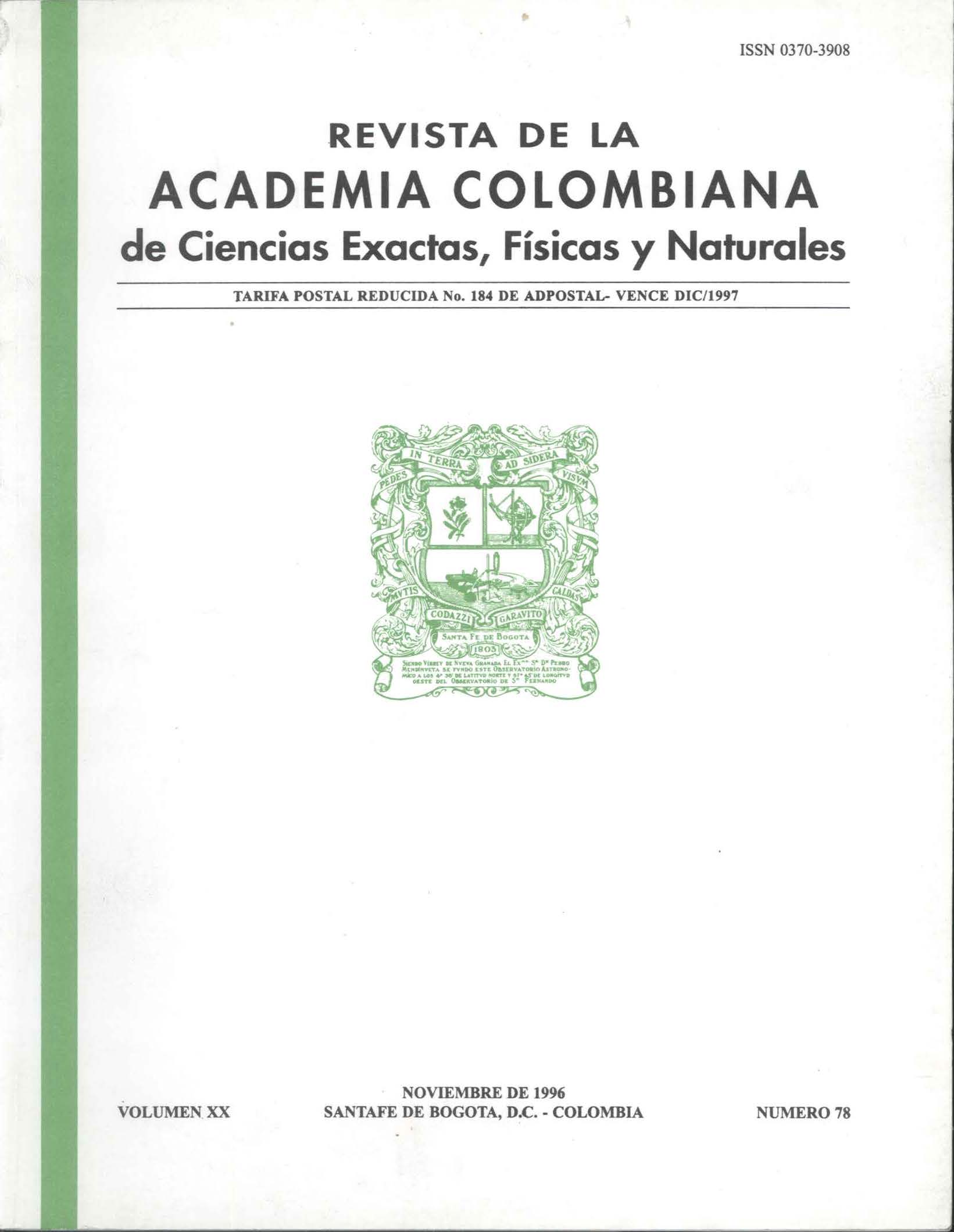Resumen
Se describe la aplicación logística en conexión con el modelo de Verhulst para la dinámica de poblaciones. Se hace énfasis en la distinción entre comportamiento regular y comportamiento caótico. El objetivo de la contribución es introducir al lector en la teoría del caos y mostrar su relevancia para las ciencias naturales.
Referencias
Binder, P. M. & D. H. Campos. 1996. Direct calculation of invariant measures for chaotic maps. Phys. Rev. E 53 (5):R4259.
Csordás, A., G. Györgyi, & P. Szépfauusy. 1993. Statistical properties of chaos demostrated in a class of one-dimensional maps. Chaos 3(1):31-49.
Delande, D. 1991. Chaos in Atomic and Molecular Physics en Giannoni M.J., A. Voros, & J. Zinn-Justin (ed.) Chaos and Quantum Physics. North-Holland. Amsterdam.
Devaney, R. L. 1989. An Introduction to Chaotic Dynamical Systems. Reading, Massachusetts: Addison-Wesley.
Devaney, R. L. 1992. A First Course in Chaotic Dynamical Systems: Theory and Experiment. Reading: Addison-Wesley.
Eckmann, J. P. & D. Ruelle. 1985. Ergodic theory of chaos and strange attractors. Rev. Mod. Phys. 57(3):617-656.
Feigenbaum, M. J. 1985. Universal Behavior in Nonlinear Systems en Campbell D. & H. Rose (ed.) Order in Chaos. North-Holland. Amsterdam. 16-39.
Février, P. 1957. Determinismo e Indeterminismo. México: Universidad Nacional Autónoma de México.
Gay, J. C., ed. 1992. Irregular Atomic Systems and Quantum Chaos. Philadelphia, Reading: Gordon and Breach. Gulick, D. 1992. Encounters with chaos. New York: McGraw Hill.
Holton, D. & R. M. May. 1995a. Chaos and one- dimensional maps en Mullin T. (ed.) The Nature of Chaos. Clarendon Press. Oxford. 95-119.
Holton, D. & R. M. May. 1995b. Models of chaos from natural selection en Mullin T. (ed.) The Nature of Chaos. Clarendon Press. Oxford, 120-148.
Hoppensteadt, F. C. 1993. Analysis and Simulation of Chaotic Systems. New York: Springer Verlag.
Jackson, E. A. 1989. Perspectives of nonlinear dynamics. 1. Cambridge: Cambridge University Press.
Jakobson, M. 1981. Absolutely continous invariant measures for one-parameter families of one- dimensional maps. Commun. Math. Phys. 81:39.
Klimontovich, Y. L. 1991. Turbulent Motion and the Structure of Chaos: A New Approach to the Statistical Theory of Open Systems. Dordrecht: Kluwer Academic.
Lazukin, V. F. 1991, KAM Theory and Semiclassical Approximations to Eigenfunctions. Berlin: Springer.
Li, T. Y. & J. Yorke. 1975. Period Three Implies Chaos. American Mathematical Monthly 82: 985-992.
Lichtenberg, A. J. & M. A. Lieberman, 1992. Regular and Chaotic Dynamics. Berlin: Springer-Verlag.
Lin, W. A. & J. B. Delos. 1993. Order and chaos in semiconductor microestructures. Chaos 3(4):1993.
Marcus, C. M., R. M. Westervelt, P. F. Hopkins, & A. C. Gossard. 1993. Conductance fluctuations and quantum chaotic scattering in semiconductor microestructures. Chaos 3(4):643.
May, R. M. 1976. Simple mathematical models with very complicated dynamics. Nature London 261:459.
Odum, E. P. 1972. Ecología. México: Nueva Editorial Interamericana
Olinck, M. 1978. An Introduction to Mathematical Models in the Social and Life Sciences. Reading. Massachusetts: Addison-Wesley.
Ott, E. 1994. Chaos in Dynamical Systems. New York: Cambridge University Press.
Patterson, D. A. & J. L. Hennessy. 1995. Organización y diseño de computadores. Madrid: McGraw-Hill.
Peitgen, H.-O., H. Jürgens, & D. Saupe. 1992. Chaos and Fractals: New Frontiers of Science. Berlin: Springer Verlag.
Peitgen, H. O. & P. H. Richter. 1986. The Beauty of Fractals: Images of Complex Dynamical Systems. Berlin: Springer.
Real Academia Española. 1992. Diccionario de la Lengua Española.
Sandri, M. 1996. Numerical Calculation of Lyapunov Exponents. The Mathematical Journal 6 (3): 78-84.
Shinbrot, T. 1995. Progress in the control of chaos. Adv. in Phys. 44(2):73-111.
Stewart, L. 1992. Does God Play Dice? Cambridge MA: Blackwell.
Strogatz, S. 1994. Nonlinear Dynamics and Chaos. Reading: Addison-Wesley.
Wolf, K. B. 1979. Integral Transforms in Science and Engineering. New York: Plenum.
Zaslavsky, G. M. 1987. Chaos in Dynamical Systems. London: Harwood Academic Publishers.

Esta obra está bajo una licencia internacional Creative Commons Atribución-NoComercial-SinDerivadas 4.0.
Derechos de autor 2024 Revista de la Academia Colombiana de Ciencias Exactas, Físicas y Naturales

